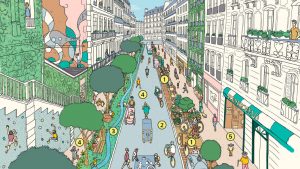“People should be able to live within a 15-minute walk of all the services they need on a daily basis.”
.
Today was the last day for submissions to the Local Plan consultation – although there’ll be more opportunities at later stages:
.
Meanwhile, in Ipswich, a piece has appeared in the local press today looking at a ‘bold vision’ for the town:
.
A new vision to improve links between different parts of Ipswich “commits to many more people living centrally and having around them all that they will need to live their lives locally”. The radical plans would see better links created between the town centre, the Waterfront, railway station and parklands, so residents can easily get to all the facilities they may need. And people living on estates on the edge of Ipswich would also benefit from £3m being allocated to improving neighbourhood shopping areas – meaning they can get groceries and supplies more easily, without having to travel far from home.
The guiding principle is the concept of a “15-minute city” pioneered by American planning expert Jane Jacobs in the 1960s. Its central idea is that people should be able to live within a 15-minute walk of all the services they need on a daily basis.
New vision for Ipswich to create ‘connected centre’ | Ipswich Star
.
The idea of the ’15-minute city’ has appeared a couple of times on these pages:
15-minute neighbourhoods for Sidmouth – Vision Group for Sidmouth
The 15-minute neighbourhood: valuing our places on foot – Vision Group for Sidmouth
.
And the idea does indeed originate from the pioneer Jane Jacobs – who has appeared again in the pages of the Arch Daily this week, and who started her activism back in the New York of the 1950s:
.
In New York City, an activist group spearheaded by Jane Jacobs stopped the construction of an interstate (I-78), which would have destroyed lower Manhattan, including Greenwich Village, SoHo, Little Italy, and Chinatown.
More Highways, More Problems: Planning the Future of Major Road Systems | ArchDaily
.
She very much felt that ‘neighbourhoods’ were what urban life should be about:
Jane Jacobs: Neighborhoods in Action / Active Living Network | ArchDaily
.
And she was indeed an interesting person:
New Documentary to Explore the Life and Legacy of Jane Jacobs | ArchDaily
Spotlight: Jane Jacobs | ArchDaily
.
And her ideas could not be more relevant to today:
.
 Think about the city or town where you live. How long does it take you to get to the grocery store on foot? Is your school or work close enough to walk to? What about a public park, a doctor’s office, a daycare, or any other places that you visit on a daily basis? While some cities have already considered what it means to live near all of these necessities, others are revamping their urban planning strategies and designing their neighborhoods to be more pedestrian-friendly with the concept of a “15-Minute City”.
Think about the city or town where you live. How long does it take you to get to the grocery store on foot? Is your school or work close enough to walk to? What about a public park, a doctor’s office, a daycare, or any other places that you visit on a daily basis? While some cities have already considered what it means to live near all of these necessities, others are revamping their urban planning strategies and designing their neighborhoods to be more pedestrian-friendly with the concept of a “15-Minute City”.
Partially inspired by the work of Jane Jacobs, who viewed neighborhoods as social connectors, the idea behind 15-minute cities was developed by Carlos Moreno, a Sorbonne professor who aimed to improve the urban quality of life. With “hyper-proximity” to amenities, jobs, government services, public parks, shopping, and a variety of entertainment only by bike or foot, the concept reconsiders how cities can be better designed to support the basic needs of residents. Within this small radius from their homes, stronger communities will be created that allows residents to feel more invested in the businesses and services in their area.
Creating a Pedestrian-Friendly Utopia Through the Design of 15-Minute Cities | ArchDaily
.
But to finish, something a little provocative about ‘density’ and ‘shared space’ – which might even be relevant to Sidmouth:
.
Density has long been an essential consideration for architects and urban planners, yet its importance has only increased as the world’s urban population skyrockets and cities become denser and denser. For much of the history of urban planning, this term has been plagued with negative associations: overcrowding, poverty, lack of safety, and so-called ‘slums.’ The garden city movement, initiated by Ebenezer Howard in 1898, sought to remedy these ills by advocating for greenbelts and anti-density planning. Le Corbusier’s Radiant City is one of the most well-known urban plans building from these ideals. Yet in the 1960’s, sociologist Jane Jacobs famously overturned these long influential urban planning concepts: she pointed out that density of buildings was not identical to overcrowding of people; suggested that some highly dense urban areas, like her neighborhood in Greenwich Village, were safer and more attractive than nearby garden city projects; and highlighted how America’s conception of ‘slums’ were often rooted in anti-immigrant and anti-Black ideologies. Density is not inherently bad, she suggested, but it has to be done well. Today, we continue to grapple with the question of how to design for our increasingly dense cities – how do we keep them open, but simultaneously private? Free, but controlled when necessary? In particular, how do we keep them safe – both from crime and, in the age of COVID-19, disease?